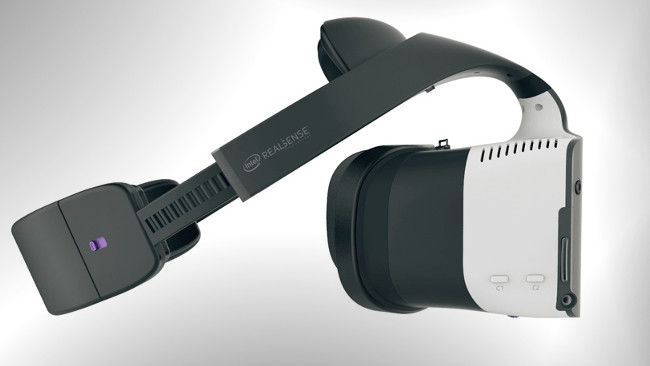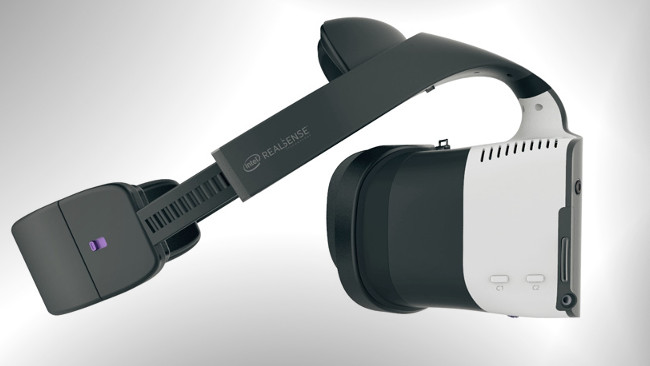
 Will Intel's Project Alloy be part of VR's next wave?
Will Intel's Project Alloy be part of VR's next wave?
Thus far, the virtual reality hardware market has been dominated by the likes of HTC, Oculus and Samsung, but that may change as a slew of other companies are preparing to enter the fray.
Virtual reality has been a hot topic for us at RedShark over the last year. Questions have surfaced that strike to the heart of the experience and its relationship to the cinema. Is VR simply a new gaming platform or something more? Is it possible to tell compelling, long form narratives in VR? What level of user interaction is suitable for VR storytelling? What impact, if any, will VR have on modern video and cinema production?
Of course, we are at the beginning stages for commercially-viable VR. I trust that most of the above questions will be answered through the normal process of humans trying things. Those creative efforts may be strained, however, by the rapidly changing VR hardware landscape, as new products means new standards and feature sets that must be considered.
Currently, there is something of a lull in new VR hardware news. Yet as the Holiday buying season draws nearer, there will undoubtedly be new entrants into the market which could shake up the present-day leaderboard.
VR's killer console?
Over the last year or so, a tiered VR hardware market has formed, with various Google Cardboard viewers at the low-end, Samsung Gear VR, with its onboard sensors, at the mid and Oculus Rift and HTC Vive as the high-end commercially-available VR products. Any apples-to-apples comparison is difficult across the board, as the products constitute a wide spectrum of price points and features.
Among the high-end offerings, HTC Vive has about a 3-to-1 edge over Oculus Rift in market share, which could be due to the delay in availability for Oculus Touch motion controllers. The Oculus Rift is more comfortable and lightweight with better resolution than the Vive, but the Vive's focus on room scale VR from launch and the bundling of its own motion controllers in the retail package was apparently enough of an incentive for early adopters.
The Oculus Rift and HTC Vive require tethering to a reasonably spec'd PC, which limits the size of their potential user bases. Over time and between product refreshes, those user bases will likely grow beyond such limitations, if only because future lower end GPUs and computer systems will be able to adequately run the present incarnations of the Vive and Rift. But a forthcoming product, which may reside just under the high-end, may be the mass market VR headset that helps break VR wide.
Sony Playstation VR is set to debut this fall (October 13th, to be precise). On sheer specs, the Playstation VR will likely fall short of the Rift and Vive, but that may miss the point. Sony Playstation 4 has an install base of over 40 million units and recent studies have indicated that, among gamers, console gamers have shown the most interest in VR, with Playstation 4 and Xbox One owners leading the pack.
Xbox One owners will have to wait awhile for any such VR peripheral, but Sony Playstation owners have been lining up, virtually speaking, for the Playstation VR, selling out each pre-order period in a matter of minutes.
Such early adopter activity might not be a reliable indicator of a platform's long-term success, but it's at least a check for the positive column. At $399 for the Playstation VR and $499 for the bundle that includes the camera and two Move controllers, the product comes in at more than the current cost for a Playstation 4, so it may be difficult to sustain that early momentum. Complicating the situation further, Sony is slated to release another version of the Playstation 4, dubbed either the Neo or Playstation 4K or 4.5, which will feature updated, beefed-up specs to support 4K gaming and, presumably, a better Playstation VR experience.
We'll have to wait to see how well the Playstation 4 variants handle VR and whether Playstation VR will satisfy its user base. But if it can deliver on its early hype, the Playstation VR may become the leader in VR for the home by year's end.
The rise of the reference designs
While the Sony Playstation VR is set to muscle into the conversation and even threaten the viability of the high-end headsets, the market for mobile VR headsets may be at the early days of a boom period. Up until now, if you wanted VR on-the-go, your choices were rather limited. You could either pair your existing smartphone with one of the vast assortment of Google Cardboard viewers or opt for a Samsung Gear VR, which is only compatible with specific models in Samsung's Galaxy line of phones and phablets. The Gear VR, besides being a generally well-designed product that has improved over generations, also has integrated electronics and sensors at a lower latency than a smartphone's own sensors, providing a smoother experience.
Presently, there are no mobile VR headsets that can compete with the Gear VR, but that is also set to change, as several flagship phones from Android device manufacturers will hit the market as part of Google's Daydream initiative. Google Daydream is, essentially, a list of required specifications for Android smartphones for use as mobile VR devices and a reference design for an adjoining headset. These specifications include better in-phone sensors that will presumably rival that of the Gear VR's sensors within the headset, while the next version of Android will have a dedicated VR mode for ease-of-use. Google will likely enter the market itself with a reference unit/package, leveraging its latest Nexus smartphone. Nearly every Android manufacturer of note has signed onto to produce a Daydream-compatible phones as well, including Samsung, which brings into question how it will differentiate its Daydream offering from the Gear VR (and whether it continues to be developed).
The popularity of Daydream will go a long way to determining if manufacturers continue to support Google's VR efforts, which should come into greater focus, again, by the end of the year. But another reference design for mobile has been unveiled that may point to an alternate path forward for mobile VR. Intel has unveiled Project Alloy, its plans for a reference design for a self-contained VR headset which does not require a phone or a tether to a PC or console.
In addition, Project Alloy ventures to brings inside-out method for monitoring body movements, room sensing and interaction with everyday objects (what Intel calls 'Merged Reality'), courtesy of Intel RealSense cameras on the headset. Project Alloy could be the beginning of a more sophisticated mobile VR experience, but we may have to wait until the middle to end of 2017 before we see such devices, as Intel is targeting next year to open up Project Alloy to developers.
The next generation(s)
Yes, we're just at the beginning of whatever VR will become, but it's not too early to ponder the features and specs of next gen VR devices. We're likely to see greater resolution, larger FOVs, better sensors and a variety of peripherals, but what else?
Expect eye tracking to be the major addition to next gen VR devices and along with it foveated rendering, which entails only rendering at full resolution the precise portion of the image that you're looking at, which is only possible via eye tracking.
At some point, VR and AR will blend into devices that can offer seamless integration of immersive and augmented experiences. Magic Leap, the ultra-secretive startup partially funded by Google, may introduce a headset that lives up to that ideal in a few years time, but we may not have to wait that long for another such effort to hit the market, even if it use a different means of blending realities.
Upstart device maker Sulon has partnered with AMD for production of the Sulon Q, which eschews the light field technology of the Magic Leap for a stereoscopic approach, using twin cameras and their feed as your view of the real world, for what AMD describes as "the first and only all-in-one, tether-free, 'wear and play' spatially-aware headset for VR and AR. Like nothing there is now. Like nothing there ever was." Such grand statements assume that another product won't come out of nowhere to steal Sulon Q's thunder before it arrives, presumably in 2017.
It may be such blending of VR and AR, as well as PC-specs and mobile convenience, that will truly characterize the coming generations. Regardless of your opinion of VR and its related technologies, those interested in VR will have many more options in the near future, which should make for a very interesting close to 2016 for that market.
Tags: VR & AR


Comments